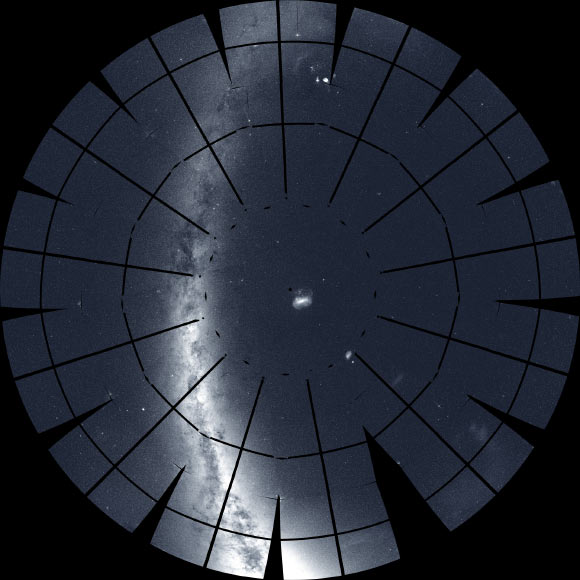TESS Captures Breathtaking Panorama of Southern Sky | Astronomy – Sci-News.com
Constructed from 208 images taken by NASA’s Transiting Exoplanet Survey Satellite (TESS) during its first year of science operations, completed on July 18, 2019, this mosaic (high-resolution version) reveals both the beauty of the cosmic landscape and the reach of the spacecraft’s cameras.

This mosaic of the southern sky was assembled from 208 TESS images. Among the many notable celestial objects visible is the glowing band (left) of the Milky Way, our home Galaxy seen edgewise, the Orion Nebula (top), a nursery for newborn stars, and the Large Magellanic Cloud (center), a nearby galaxy located about 163,000 light-years away. The prominent dark lines are gaps between the detectors in TESS’ camera system. Image credit: NASA / MIT / TESS / Ethan Kruse, USRA.
Within this scene, TESS has discovered 29 exoplanets (including three small planets in orbit around the red dwarf GJ 357, a sub-Neptune and an Earth-sized planet around HD 21749, and three small planets around the red dwarf L 98-59) and more than 1,000 candidate planets astronomers are now investigating.
“Analysis of TESS data focuses on individual stars and planets one at a time,” said Dr. Ethan Kruse, a postdoctoral researcher at NASA’s Goddard Space Flight Center.
“But I wanted to step back and highlight everything at once, really emphasizing the spectacular view TESS gives us of the entire sky.”
TESS is the first space-based, all-sky surveyor to search for alien worlds. It has four wide field-of-view optical cameras — which carry a total of 16 charge-coupled devices (CCDs) — arranged to view a long strip of the sky called an observation sector.
For the first year of its planned two-year mission, TESS divided the southern sky into 13 sectors and imaged each one of them for nearly a month.
Remarkably, the TESS cameras capture a full sector of the sky every 30 minutes as part of its search for phenomena called exoplanet transits. A transit occurs when a planet passes in front of its star from the observer’s perspective, causing a periodic and regular dip in the star’s brightness.
During the satellite’s first year of operations, each of its CCDs captured 15,347 30-minute science images.
These images are just a part of more than 20 terabytes of southern sky data TESS has returned, comparable to streaming nearly 6,000 high-definition movies.
After completing its southern survey, TESS turned north to begin a year-long study of the northern sky.




